Embodiment
 |
||||||||
 |
 |
|||||||
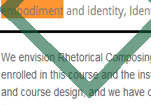 |
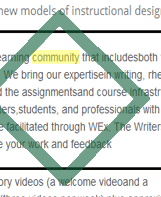 |
 |
||||||
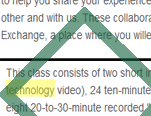 |
||||||||
 |
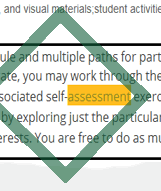 |
|||||||
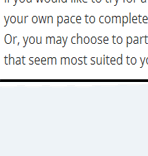 |
||||||||
This section is organized according to Critel’s topoi: technology, assessment, embodiment, community (see introduction). Our analysis of these sample courses is driven by complex intersections among these four topoi that, in turn, have generated the following questions:
- To what extent do our hopes for creating online communities of learners lead us to develop participation policies that obfuscate notions of difference?
- In what ways do learning outcomes and methods of assessment for evaluating participation in MOOCs lag behind in our current cultural and technological moment?
- How might more precise definitions of participation allow us to avoid commonsensical (and potentially normative) conceptions of knowledge, embodiment, and intellectual work in MOOCs?
EMBODIMENT
Critel writes that “instructors should be interrogating their expectations about student bodies and what a 'normal' student is, beyond simply adjusting for students who are visibly physically disabled” (192). A commonsensical and uncritical notion of technology suggests that, by definition, online courses mediated by information and communication technologies would automatically be more accessible. Taken together, technology studies scholars like Andrew Feenberg and Stuart A. Selber demonstrate technologies themselves are embedded in wider ideological and rhetorical constructs that must themselves be consistently identified, made visible, defined, and interrogated. And as current disability scholars articulate coherently in the Kairos journal’s special issue, "Multimodality in Motion," technologically mediated accessibility, like all types of accessibility, cannot ever be assumed or taken for granted but must be constructed rhetorically and then made visible and available to all.
Udacity Course: Design of Everyday Things (UDACITY)
The Design of Everyday Things course description addresses potential students by appealing to their sense of embodied engagement within physical spaces. “When you decide what seat to take in an auditorium you’re designing your experience. When you rearrange the furniture in a room or draft an email, you’re designing.” If we follow Critel and interrogate our expectations about student bodies, this syllabus statement imagines an able bodied person who chooses a seat and rearranges furniture. The syllabus invokes—assumptions about how we have power over spaces when, in fact, inaccessible spaces actually have power over us
The syllabus language continues to promote the course:“It’s intended to be enjoyable and informative for anyone curious about design: everyday people, technical people, designers, and non-designers alike.” (Design of Everyday Things). These naïve notions of “everyday people” are intended to welcome both specialists and nonspecialists, but the design content uses a personalized universal-design approach rather than a critical approach. We recognize that real students’ bodies are missing. Will this course, based on the instructor’s popular book, ever then offer nuanced understandings of how designs often elide individual identities and reinforce dominant power structures in contemporary American culture? The pedigree and corporate affiliations of the book’s author Don Norman and the other two course team members, including coteacher Kristian Simsarian and Udacity course designer Chelsey Glasson, who hopes the course will “inspire those new to design to explore user experience and design careers,” all suggest the course will offer a value-neutral, ahistorical and corporate-friendly perspective rather than a critical studies perspective on the concept of design.
[Go to "Community"]